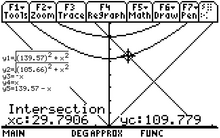Spacetime
| Part of a series on |
| Spacetime |
|---|
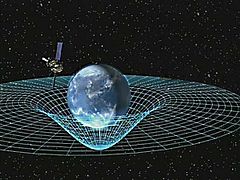 |
In physics, spacetime is any mathematical model that combines space and time into a single interwoven continuum.
Until the turn of the 20th century, the assumption had been that the 3D geometry of the universe (its description in terms of locations, shapes, distances, and directions) was distinct from time (the measurement of when events occur within the universe). However, Albert Einstein's 1905 special theory of relativity postulated that the speed of light through empty space has one definite value—a constant—that is independent of the motion of the light source. Einstein's equations precisely described important consequences of this fact: both the shape of space and the measurement of time simultaneously change for observers who have different relative velocities, which is to say, for observers who have different "inertial frames of reference."
Einstein's theory was framed in terms of kinematics (the study of moving bodies), and showed how measurements of space and time varied for observers in different reference frames. His theory was a breakthrough advance over Lorentz's 1904 theory of electromagnetic phenomena and Poincaré's electrodynamic theory. Although these theories included equations identical to those that Einstein introduced (i.e. the Lorentz transformation), they were essentially ad hoc models proposed to explain the results of various experiments—including the famous Michelson–Morley interferometer experiment—that were extremely difficult to fit into existing paradigms.
In 1908, Hermann Minkowski, expanding upon Einstein's work, presented a geometric interpretation of special relativity that fused time and the three spatial dimensions of space into a single four-dimensional continuum now known as Minkowski space—an example of what mathematicians call a 4‑dimensional "manifold." A key feature of this interpretation is the definition of a "spacetime interval" that combines distance and time. Although measurements of distance and time between events differ among observers, the spacetime interval is independent of the inertial frame of reference in which they are recorded.
Introduction
Definitions
Non-relativistic classical mechanics treats time as a universal quantity of measurement which is uniform throughout space and which is separate from space. Classical mechanics assumes that time has a constant rate of passage that is independent of the state of motion of an observer, or indeed of anything external.[1] Furthermore, it assumes that space is Euclidean, which is to say, it assumes that space follows the geometry of common sense.[2]
In the context of special relativity, time cannot be separated from the three dimensions of space, because the observed rate at which time passes for an object depends on the object's velocity relative to the observer. General relativity, in addition, provides an explanation of how gravitational fields can slow the passage of time for an object as seen by an observer outside the field.
Mathematically, spacetime is a "manifold", which is to say, it is a "topological space" that locally resembles Euclidean space near each point. By analogy, at small enough scales, a globe appears flat.[3] An extremely large scale factor, (conventionally called the "speed of light") relates distances measured in space with distances measured in time. The magnitude of this scale factor (nearly 300,000 km in space being equivalent to 1 s in time), along with the fact that spacetime is a manifold, implies that at ordinary, non-relativistic speeds and at ordinary, human-scale distances, there is little that humans might observe which is noticeably different from what they might observe if the world were Euclidean. It was only with the advent of sensitive scientific measurements in the mid-1800s, such as the Fizeau experiment and the Michelson–Morley experiment, that puzzling discrepancies began to be noted between observation versus predictions based on the implicit assumption of Euclidean space.[4]
Things that happen in spacetime are called "events". An event is something that happens instantaneously at a single point in spacetime, represented by a set of coordinates x, y, z and t. Events have neither duration in time nor extent in space. The tokens typically used in popular expositions of relativity to represent events—sparks, firecrackers, lightning bolts and the like—are not events because they have finite durations and extents. Unlike the analogies used to explain events, mathematical events, since they have no duration, have no speed and cannot be in motion.
On the other hand, the path of a particle through spacetime can be considered to be a succession of events. The series of events can be linked together to form a line which represents a particle's progress through spacetime. That line is called the particle's "world line".[5]: 105

In special relativity, an observer is a frame of reference from which a set of objects or events are being measured. This usage differs significantly from the ordinary English meaning of the term. Reference frames are inherently nonlocal constructs, and it does not make sense to speak of an observer as having a location. In Fig. 1‑1, imagine that a scientist is in control of a dense lattice of clocks, synchronized within her reference frame, that extends indefinitely throughout the three dimensions of space. Her location within the lattice is not important. She uses her latticework of clocks to determine the time and position of events taking place within its reach. The term "observer" refers to the entire ensemble of clocks associated with one inertial frame of reference.[6] An ideal observer experiences no time delays between the firing of an event and its recording. In real life, there will typically be delays between the emission of a signal and its detection. However, in the data reduction following an experiment, the time when a signal is received will be corrected to reflect its actual time were it to have been recorded by an idealized lattice of clocks.
Physicists distinguish between what one "measures" or "observes" (after one has factored out signal propagation delays), versus what one "sees" (what one visualizes without such corrections). Failure to understand the difference between what one measures/observes versus what one sees is the source of much error among beginning students of relativity.[7]
History
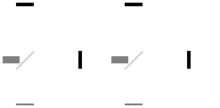
By the mid-1800s, various experiments such as the observation of the Arago spot and differential measurements of the speed of light in air versus water were considered to have proven the wave nature of light as opposed to corpuscular theory.[8] Waves implied the existence of a medium which waved, but attempts to measure the properties of the hypothetical luminiferous aether implied by these experiments provided contradictory results. For example, the Fizeau experiment of 1851 demonstrated that the speed of light in flowing water was less than the sum of the speed of light in air plus the speed of the water by an amount dependent on the water's index of refraction. Among other issues, the dependence of the partial aether-dragging implied by this experiment on the index of refraction (which is dependent on wavelength) led to the unpalatable conclusion that aether simultaneously flows at different speeds for different colors of light.[9] The famous Michelson–Morley experiment of 1887 showed no differential influence of Earth's motions through the hypothetical aether on the speed of light, and the most likely explanation, complete aether dragging, was in conflict with the observation of stellar aberration (Fig. 1‑3).[4]

George Francis FitzGerald in 1889 and Hendrik Lorentz in 1892 independently proposed that material bodies traveling through the fixed aether were physically affected by their passage, contracting in the direction of motion by an amount that was exactly what was necessary to explain the negative results of the Michelson-Morley experiment. (No length changes occur in directions transverse to the direction of motion.) By 1904, Lorentz had expanded his theory such that he had arrived at equations formally identical with those that Einstein were to derive later (i.e. the Lorentz transform), but with a fundamentally different interpretation. As a theory of dynamics (the study of forces and torques and their effect on motion), his theory assumed actual physical deformations of the physical constituents of matter, and it predicted various physical effects which might be observable.[10]: 163–174 For example, most physicists believed that Lorentz contraction would be detectable by such experiments as the Trouton–Noble experiment or the Experiments of Rayleigh and Brace.[11]: 64 However, these gave negative results, and in his 1904 theory of the electron, Lorentz explained these negative results as an inevitable consequence of his transforms. Poincaré, correcting some errors in Lorentz's analysis, demonstrated the non-detectability of the aether, but continued to believe in the dynamical interpretation of the Lorentz transform for the rest of his life.[10]: 163–174
Present day hindsight tends to place the culmination of the turn-of-the-20th-century crisis in physics on the Michelson and Morley experiment. But to Einstein, his ultimate inspiration may have been inconsistencies that he perceived in the manner in which Maxwell's theory of electromagnetism was being interpreted. Although in 1905, Einstein wrote of the Moving magnet and conductor problem as being generally understood as leading to asymmetries, these asymmetries do not appear to have been noted as a significant issue requiring explanation by any of the leading expositors of Maxwell's theory, including Hertz, Lorentz, and Maxwell himself.[11]: 135–142
Einstein's theory of special relativity, introduced in 1905, provided a complete resolution to these and other major physics puzzles, and it made startling predictions that have since been repeatedly confirmed. Einstein performed his analyses in terms of kinematics (the study of moving bodies without reference to forces) rather than dynamics. It would appear that he did not at first think geometrically about spacetime. It was Einstein's former mathematics professor, Hermann Minkowski, who was to provide a geometric interpretation of special relativity.[12]: 219
Einstein was initially dismissive of the geometric interpretation of special relativity, regarding it as "überflüssige Gelehrsamkeit" (superfluous learnedness). However, the geometric interpretation of relativity was to prove vital to Einstein's later development of general relativity, and in 1916, Einstein fully acknowledged his indebtedness to Minkowski, whose interpretation greatly facilitated the transition to general relativity.[10]: 151–152 The spacetime of special relativity has since come to be known as Minkowski spacetime.
Spacetime interval
Although time comes in as a fourth dimension, it is treated differently than the spatial dimensions. Minkowski space hence differs in important respects from four-dimensional Euclidean space. The fundamental reason for merging space and time into spacetime is that space and time are separately not invariant, which is to say that, under the proper conditions, different observers will disagree on the length of time between two "events" (because of time dilation) or the distance between the two events (because of length contraction). But special relativity provides a new invariant, called the "spacetime interval", which combines distances in space and in time. All observers who measure time and distance carefully will find the same spacetime interval between any two events. Suppose an observer measures two events as being separated by a time and a spatial distance . Then the spacetime interval between the two events is given by
- (or for three space dimensions, )[Note 1]

The equation above is simply an expression of the Pythagorean theorem, except with a minus sign between the and the terms. Note also that the spacetime interval is the quantity , not itself. The reason is that unlike distances in Euclidean geometry, intervals in Minkowski spacetime can be negative. Rather than deal with square roots of negative numbers, physicists customarily regard as a distinct symbol in itself, rather than the square of something.[12]: 217
Because of the minus sign, the spacetime interval between two events can be zero. Spacetime intervals are zero when . In other words, the spacetime interval is zero for something moving at the speed of light. A photon arriving in our eye from a distant star will not have aged, despite having (from our perspective) spent years in its passage.
A spacetime diagram is typically drawn with only a single space and a single time coordinate. Fig. 1‑4 presents a spacetime diagram illustrating the "world lines" (i.e. paths in spacetime) of two photons, A and B, originating from the same event and going in opposite directions. In addition, C illustrates the world line of a slower-than-light-speed object. The vertical time coordinate is scaled by so that it has the same units (meters) as the horizontal space coordinate. Since photons travel at the speed of light, their world lines have a slope of ±1. In other words, every meter that a photon travels to the left or right requires approximately 3.3 nanoseconds of time.
Reference frames
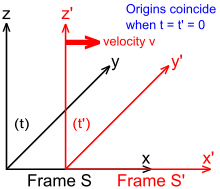
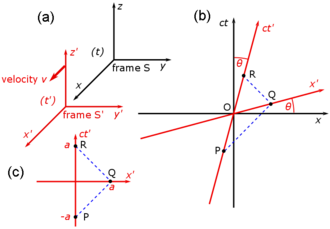
In comparing measurements made by relatively moving observers in different reference frames, it is useful to work with the frames in a standard configuration. In Fig. 1‑5, two Galilean reference frames (i.e. conventional 3-space frames) are displayed in relative motion. Frame S belongs to a first observer O, and frame S' (pronounced "S prime") belongs to a second observer O'.
- The x, y, z axes of frame S are oriented parallel to the respective primed axes of frame S'.
- Frame S' moves in the x-direction of frame S with a constant velocity v as measured in frame S.
- The origins of frames S and S' are coincident when time t = 0 for frame S and t' = 0 for frame S'.[5]: 107
Fig. 1‑6a redraws Fig. 1‑5 in a different orientation. Fig. 1‑6b illustrates a spacetime diagram from the viewpoint of observer O. Since S and S' are in standard configuration, their origins coincide at times t = 0 in frame S and t' = 0 in frame S'. The ct' axis passes through the events in frame S' which have x' = 0. But the points with x' = 0 are moving in the x-direction of frame S with velocity v, so that they are not coincident with the ct axis at any time other than zero. Therefore, the ct' axis is tilted with respect to the ct axis by an angle θ given by
The x' axis is also tilted with respect to the x axis. To determine the angle of this tilt, we recall that the slope of the world line of a light pulse is always ±1. Fig. 1‑6c presents a spacetime diagram from the viewpoint of observer O'. Event P represents the emission of a light pulse at x' = 0, ct' = -a. The pulse is reflected from a mirror situated a distance a from the light source (event Q), and returns to the light source at x' = 0, ct' = a (event R).
The same events P, Q, R are plotted in Fig. 1‑6b in the frame of observer O. The light paths have slopes = 1 and −1 so that ΔPQR forms a right triangle. Since OP = OQ = OR, the angle between x' and x must also be θ.[5]: 113–118
While the rest frame has space and time axes that meet at right angles, the moving frame is drawn with axes that meet at an acute angle. The frames are actually equivalent. The asymmetry is due to unavoidable distortions in how spacetime coordinates can map onto a Cartesian plane, and should be considered no stranger than the manner in which, on a Mercator projection of the Earth, the relative sizes of land masses near the poles (Greenland and Antarctica) are highly exaggerated relative to land masses near the Equator.
Light cone

In Fig. 1-7, event O is centered at the origin of the spacetime diagram, and the two diagonal lines represent all events that have zero spacetime interval with respect to the origin event. These two lines form what is called the "light cone", since as illustrated in Fig. 1‑8, if another dimension is added to the diagram, the appearance would be that of two cones meeting with their apexes at the origin and centered around the time axis, one cone extending into the future, the other into the past. Since the spacetime interval is an invariant, all observers will assign the same events to the light cone of a given event. This statement is equivalent to the second postulate of special relativity: all observers measure the speed of light to be .[12]: 220

The light cone divides spacetime into separate regions. The interior of the future light cone consists of events that are separated from the origin event by more time than there is space: these events comprise the "timelike future" of the origin event. Likewise, the "timelike past" comprises the interior events of the past light cone. Since in timelike intervals, the separation in time is greater than the separation in space, timelike intervals are positive. The region exterior to the light cone consists of events that are separated from the origin event by more space than there is time. These events comprise the spacelike "Elsewhere" of the origin event. Events on the light cone itself are said to be "lightlike" (or null) separated from the origin. Because of the invariance of spacetime, all observers will agree on this division of spacetime.[12]: 220
The light cone has an essential role in defining the concept of causality. Signals cannot travel faster than the speed of light. In Fig. 1‑7, it is possible for a slower-than-or-equal-to-light-speed signal to travel from the position and time of O, to the position and time of D. It is hence possible for event O to have a causal influence on event D. The future light cone contains all of the events that could be causally influenced by O. Likewise, it is possible for a slower-than-or-equal-to-light-speed signal to travel from the position and time of A, to the position and time of O. The past light cone contains all of the events that could have a causal influence on O. In contrast, in the Elsewhere region, event O cannot affect or be affected by event C, nor can event O affect or be affected by event B. There is no causal relationship between O and any events in the Elsewhere region.[13]
Relativity of simultaneity
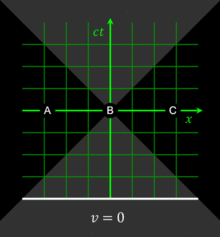
All observers will agree that for any given event, an event within the given event's future light cone occurs after the given event. Likewise, for any given event, an event within the given event's past light cone occurs before the given event. The before-after relationship observed for timelike-separated events remains unchanged no matter what the reference frame of the observer, i.e. no matter how the observer may be moving. The situation is quite different for spacelike-separated events. Fig. 1‑7 was drawn from the reference frame of an observer moving at v = 0. From this reference frame, event C is observed to occur after event O, and event B is observed to occur before event O. From a different reference frame, the orderings of these non-causally-related events can be reversed. In particular, one notes that if two events are simultaneous in a particular reference frame, they are necessarily separated by a spacelike interval and thus are noncausally related. The observation that simultaneity is not absolute, but depends on the observer's reference frame, is termed the relativity of simultaneity.[14]
Fig. 1-9 illustrates the use of spacetime diagrams in the analysis of the relativity of simultaneity. The events in spacetime are invariant, but the coordinate frames transform as discussed above for Fig. 1‑6. The three events (A, B, C) are simultaneous from the reference frame of an observer moving at v = 0. From the reference frame of an observer moving at v = 0.3 c, the events appear to occur in the order C, B, A. From the reference frame of an observer moving at v = −0.5 c, the events appear to occur in the order A, B, C. The white line represents a plane of simultaneity being moved from the past of the observer to the future of the observer, highlighting events residing on it. The gray area is the light cone of the observer, which remains invariant.
The spacetime interval gives the same distance that an observer would measure if the events being measured were simultaneous to the observer. The spacetime interval hence provides a measure of "proper distance", i.e. the true distance in spacetime. Likewise, the spacetime interval gives the same measure of time as would be presented by the cumulative ticking of a clock that moves along a given world line. The spacetime interval hence provides a measure of "proper time".[12]: 220–221
Invariant hyperbola
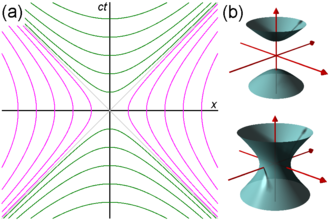
In ordinary Euclidean space, the set of points that are equidistant from an origin form a circle (in two dimensions) or a sphere (in three dimensions). In Minkowski spacetime, the points at some constant spacetime interval from the origin form a curve given by the equation
The example above is the equation of a hyperbola in an x–ct spacetime diagram, which is termed an "invariant hyperbola".
In Fig. 1-10a, the magenta hyperbolae connect events of equal spacelike separation from the origin, while the green hyperbolae connect events of equal timelike separation from the origin.
Please note a confusing point of nomenclature: The magenta hyperbolae, which cross the x axis, are termed "timelike" (not spacelike) hyperbolae because all intervals along the hyperbola are timelike intervals. Because of that, these hyperbolae represent actual paths that can be traversed by accerating particles in spacetime. On the other hand, the green hyperbolae, which cross the ct axis, are termed "spacelike" hyperbolae because all intervals along the hyperbolae are spacelike intervals.
Fig. 1‑10b shows that when viewed in an extra dimension of space, the timelike invariant hyperbolae generate hyperboloids of one sheet, while the spacelike invariant hyperbolae generate hyperboloids of two sheets.
Time dilation and length contraction
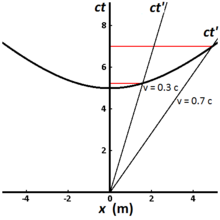
Fig. 1-11 illustrates the invariant hyperbola for all events that can be reached from the origin in a proper time of 5 meters (approximately 1.67×10−8s). Different world lines represent clocks moving at different speeds. A clock that is stationary with respect to the observer has a world line that is vertical, and the elapsed time measured by the observer is the same as the proper time. For a clock traveling at 0.3c, the elapsed time measured by the observer is 5.24 meters (1.75×10−8s), while for a clock traveling at 0.7c, the elapsed time measured by the observer is 7.00 meters (2.34×10−8s). This illustrates the phenomenon known as "time dilation". Clocks that travel faster take longer (in the observer frame) to tick out the same amount of proper time, and they travel further along the x–axis than they would have without time dilation.[12]: 220–221 The measurement of time dilation by two observers in different inertial reference frames is mutual. If observer O measures the clocks of observer O' as running slower in his frame, observer O' in turn will measure the clocks of observer O as running slower.

Length contraction, like time dilation, is a manifestation of the relativity of simultaneity. Measurement of length requires measurement of the spacetime interval between two events that are simultaneous in one's frame of reference. But events that are simultaneous in one frame of reference are, in general, not simultaneous in other frames of reference.
Fig. 1-12 illustrates the motions of a 1 m rod that is traveling at 0.5 c along the x axis. The edges of the blue band represent the world lines of the rod's two endpoints. The invariant hyperbola illustrates events separated from the origin by a spacelike interval of 1 m. The endpoints O and B measured when t' = 0 are simultaneous events in the S' frame. But to an observer in frame S, events O and B are not simultaneous. To measure length, the observer in frame S measures the endpoints of the rod as projected onto the x-axis along their world lines. The projection of the rod's "world sheet" onto the x axis yields the foreshortened length OC.[5]: 125
(not illustrated) Drawing a vertical line through A so that it intersects the x' axis demonstrates that, even as OB is foreshortened from the point of view of observer O, OA is likewise foreshortened from the point of view of observer O'. In the same way that each observer measures the other's clocks as running slow, each observer measures the other's rulers as being contracted.
Measurement versus visual appearance
Time dilation and length contraction are not optical illusions, but genuine effects. Measurements of these effects are not an artifact of Doppler shift, nor are they the result of neglecting to take into account the time it takes light to travel from an event to an observer.
That being said, scientists make a fundamental distinction between measurement or observation on the one hand, versus visual appearance, or what one sees.

For many years, the distinction between the two had not been generally appreciated. For example, it had generally been thought that a length contracted object passing by an observer would in fact actually be seen as length contracted. In 1959, James Terrell and Roger Penrose independently pointed out that differential time lag effects in signals reaching the observer from the different parts of a moving object result in a fast moving object's visual appearance being quite different from its measured shape. For example, a receding object would appear contracted, an approaching object would appear elongated, and a passing object would have a skew appearance that has been likened to a rotation.[15][16][17][18] A sphere in motion retains the appearance of a sphere, although images on the surface of the sphere will appear distorted.[19]

Fig. 1‑13 illustrates a cube viewed from a distance of four times the length of its sides. At high speeds, the sides of the cube that are perpendicular to the direction of motion appear hyperbolic in shape. The cube is actually not rotated. Rather, light from the rear of the cube takes longer to reach one's eyes compared with light from the front, during which time the cube has moved to the right. This illusion has come to be known as "Terrell rotation" or the "Terrell–Penrose effect".[Note 2]
Another example where visual appearance is at odds with measurement comes from the observation of apparent superluminal motion in various radio galaxies, BL Lac objects, quasars, and other astronomical objects that eject relativistic-speed jets of matter at narrow angles with respect to the viewer. An optical illusion results giving the appearance of faster than light travel.[20][21][22] In Fig. 1‑14, galaxy M87 streams out a high-speed jet of subatomic particles almost directly towards us, but Penrose–Terrell rotation causes the jet to appear to be moving laterally in the same manner that the appearance of the cube in Fig. 1‑13 has been stretched out.[23]
Mutual time dilation and the twin paradox
Mutual time dilation
Mutual time dilation and length contraction tend to strike beginners as inherently self-contradictory concepts. The worry is that if observer A measures observer B's clocks as running slowly, simply because B is moving at speed v relative to A, then the principle of relativity requires that observer B likewise measures A's clocks as running slowly. This is an important question that "goes to the heart of understanding special relativity."[12]: 198
Basically, A and B are performing two different measurements.
In order to measure the rate of ticking of one of B's clocks, A must use two of his own clocks, the first to record the time where B's clock first ticked at the first location of B, and second to record the time where B's clock emitted its second tick at the next location of B. Observer A needs two clocks because B is moving, so a grand total of three clocks are involved in the measurement. A's two clocks must be synchronized in A's frame. Conversely, B requires two clocks synchronized in her frame to record the ticks of A's clocks at the locations where A's clocks emitted their ticks. Therefore, A and B are performing their measurements with different sets of three clocks each. Since they are not doing the same measurement with the same clocks, there is no inherent necessity that the measurements be reciprocally "consistent" such that, if one observer measures the other's clock to be slow, the other observer measures the one's clock to be fast.[12]: 198–199
In regards to mutual length contraction, Fig. 1‑12 illustrates that the primed and unprimed frames are mutually rotated by a hyperbolic angle (analogous to ordinary angles in Euclidean geometry).[Note 3] Because of this rotation, the projection of a primed meter-stick onto the unprimed x-axis is foreshortened, while the projection of an unprimed meter-stick onto the primed x'-axis is likewise foreshortened.

Fig. 1-15 reinforces previous discussions about mutual time dilation. In this figure, Events A and C are separated from event O by equal timelike intervals. From the unprimed frame, events A and B are measured as simultaneous, but more time has passed for the unprimed observer than has passed for the primed observer. From the primed frame, events C and D are measured as simultaneous, but more time has passed for the primed observer than has passed for the unprimed observer. Each observer measures the clocks of the other observer as running more slowly.[5]: 124
Please note the importance of the word "measure". An observer's state of motion cannot affect an observed object, but it can affect the observer's observations of the object.
In Fig. 1-15, each line drawn parallel to the x axis represents a line of simultaneity for the unprimed observer. All events on that line have the same time value of ct. Likewise, each line drawn parallel to the x' axis represents a line of simultaneity for the primed observer. All events on that line have the same time value of ct'.
Twin paradox
The twin paradox is a thought experiment involving identical twins, one of whom makes a journey into space in a high-speed rocket, returning home to find that the twin who remained on Earth has aged more. This result appears puzzling because each twin observes the other twin as moving, and so at first glance, it would appear that each should find the other to have aged less. The twin paradox sidesteps the justification for mutual time dilation presented above by avoiding the requirement for a third clock.[12]: 207 Nevertheless, the "twin paradox" is not a paradox because it is easily understood within the context of special relativity.
The impression that a paradox exists stems from a misunderstanding of what special relativity states. Special relativity does not declare all frames of reference to be equivalent, only inertial frames. The traveling twin's frame is not inertial during periods when she is accelerating. Furthermore, the difference between the twins is observationally detectable: the traveling twin needs to fire her rockets to be able to return home, while the stay-at-home twin does not.[24]
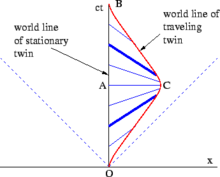
Deeper analysis is needed before we can understand why these distinctions should result in a difference in the twins' ages. Consider the spacetime diagram of Fig. 1‑16. This presents the simple case of a twin going straight out along the x axis and immediately turning back. From the standpoint of the stay-at-home twin, there is nothing puzzling about the twin paradox at all. The proper time measured along the traveling twin's world line from O to C, plus the proper time measured from C to B, is less than the stay-at-home twin's proper time measured from O to A to B. More complex trajectories require the evaluation the integral of the proper times along the curve (i.e. the path integral) to calculate the total amount of proper time experienced by the traveling twin.[24]
Complications arise if the twin paradox is analyzed from the traveling twin's point of view.
For the rest of this discussion, we adopt Weiss's nomenclature, designating the stay-at-home twin as Terence and the traveling twin as Stella.[24]
We had previously noted that Stella is not in an inertial frame. Given this fact, it is sometimes stated that full resolution of the twin paradox requires general relativity.[24] Analyzed in Stella's frame, she is motionless for the entire trip. When she fires her rockets for the turnaround, she experiences a pseudo-gravitational field that exactly cancels the force of her rockets, so she remains motionless.[24]
Figs. 1-9 and 1-16 illustrate the concept of lines (planes) of simultaneity: Lines parallel to the observer's x-axis (xy-plane) represent sets of events that are simultaneous in the observer frame. In Fig. 1‑16, the blue lines connect events on Terence's world line which, from Stella's point of view, are simultaneous with events on her world line. (Terence, in turn, would observe a set of horizontal lines of simultaneity.) Throughout both the outbound and the inbound legs of Stella's journey, she measures Terence's clocks as running slower than her own. But during the turnaround (i.e. between the bold blue lines in the figure), a shift takes place in the angle of her lines of simultaneity, corresponding to a rapid skip-over of the events in Terence's world line that Stella considers to be simultaneous with her own. Therefore, at the end of her trip, Stella finds that Terence has aged more than she has.[24]
Gravitation
This introductory section has focused on the spacetime of special relativity, since it is the easiest to describe. Minkowski spacetime is flat, takes no account of gravity, is uniform throughout, and serves as nothing more than a static background for the events that take place in it. The presence of gravity greatly complicates the description of spacetime. In general relativity, spacetime is no longer a static background, but actively interacts with the physical systems that it contains. Spacetime curves in the presence of matter, can propagate waves, bends light, and exhibits a host of other phenomena.[12]: 221 A few of these phenomena are described in the later sections of this article.
Basic mathematics of spacetime
The Galilean transformations
A basic goal is to be able to compare measurements made by observers in relative motion. Say we have an observer O in frame S who has measured the time and space coordinates of an event, assigning this event three Cartesian coordinates and the time as measured on his lattice of synchronized clocks (x, y, z, t) (see Fig. 1‑1). A second observer O' in a different frame S' measures the same event in her coordinate system and her lattice of synchronized clocks (x', y', z', t'). Since we are dealing with inertial frames, neither observer is under acceleration, and a simple set of equations allows us to relate coordinates (x, y, z, t) to (x', y', z', t'). Given that the two coordinate systems are in standard configuration, meaning that they are aligned with parallel (x, y, z) coordinates and that t = 0 when t' = 0, the coordinate transformation is as follows:[25][26]
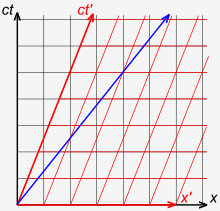
Fig. 2-1 illustrates that in Newton's theory, time is universal, not the velocity of light.[27]: 36–37 Consider the following thought experiment: The red arrow illustrates a train that is moving at 0.4 c with respect to the platform. Within the train, a passenger shoots a bullet with a speed of 0.4 c in the frame of the train. The blue arrow illustrates that a person standing on the train tracks measures the bullet as traveling at 0.8 c. This is in accordance with our naive expectations.
More generally, assume that frame S' is moving at velocity v with respect to frame S. Within frame S', observer O' measures an object moving with velocity u'. What is its velocity u with respect to frame S? Since x = ut, x' = x − vt, and t = t', we can write x' = ut − vt = (u − v)t = (u − v)t'. This leads to u' = x'/t' and ultimately
- or
which is the common-sense Galilean law for the addition of velocities.
Example: Terence and Stella are at a 100 meter race. Terence is an official at the starting blocks, while Stella is a participant. At t = t' = 0, Stella begins running at a speed of 9 m/s. At 5 s into the race, Terence, in his unprimed coordinate system, observes their mother, situated 45 m downfield from the starting blocks and 10 m to the left (45 m, 10 m, 0 m, 5 s), waving at Stella. Stella, in her primed coordinate system, observes their mother waving at her at x' = x - vt = 45 - 9×5 = 0 m, y' = y = 10 m, i.e. she observes their mother as waving from directly to her left (0 m, 10 m, 0 m, 5 s).
Relativistic composition of velocities

The composition of velocities is quite different in relativistic spacetime. To reduce the complexity of the equations slightly, we introduce a common shorthand for the ratio of the speed of an object relative to light,
Fig. 2-2a illustrates a red train that is moving forward at a speed given by v/c = β = s/a. From the primed frame of the train, a passenger shoots a bullet with a speed given by u'/c = β' = n/m, where the distance is measured along a line parallel to the red x' axis rather than parallel to the black x axis. What is the composite velocity u of the bullet relative to the platform, as represented by the blue arrow? Referring to Fig. 2‑2b:
- From the platform, the composite speed of the bullet is given by u = c(s + r)/(a + b).
- The two yellow triangles are similar because they are right triangles that share a common angle α. In the large yellow triangle, the ratio s/a = v/c = β.
- The ratios of corresponding sides of the two yellow triangles are constant, so that r/a = b/s = n/m = β'. So b = u's/c and r = u'a/c.
- Substitute the expressions for b and r into the expression for u in step 1 to yield Einstein's formula for the addition of velocities:[27]: 42–48
The relativistic formula for addition of velocities presented above exhibits several important features:
- If u' and v are both very small compared with the speed of light, then the product vu'/c2 becomes vanishingly small, and the overall result becomes indistinguishable from the Galilean formula (Newton's formula) for the addition of velocities: u = u' + v. The Galilean formula is a special case of the relativistic formula applicable to low velocities.
- If u' is set equal to c, then the formula yields u = c regardless of the starting value of v. The velocity of light is the same for all observers regardless their motions relative to the emitting source.[27]: 49
Time dilation and length contraction revisited

We had previously discussed, in qualitative terms, time dilation and length contraction. It is straightforward to obtain quantitative expressions for these effects. Fig. 2‑3 is a composite image containing individual frames taken from two previous animations, simplified and relabeled for the purposes of this section.
To reduce the complexity of the equations slightly, we see in the literature a variety of different shorthand notations for ct :
- and are common.
- One also sees very frequently the use of the convention
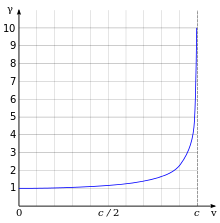
In Fig. 2-3a, segments OA and OK represent equal spacetime intervals. Time dilation is represented by the ratio OB/OK. The invariant hyperbola has the equation w = √x2 + k2 where k = OK, and the red line representing the world line of a particle in motion has the equation w = x/β = xc/v. A bit of algebraic manipulation yields
The expression involving the square root symbol appears very frequently in relativity, and one over the expression is called the Lorentz factor, denoted by the Greek letter gamma :[28]
We note that if v is greater than or equal to c, the expression for becomes physically meaningless, implying that c is the maximum possible speed in nature. Next, we note that for any v greater than zero, the Lorentz factor will be greater than one, although the shape of the curve is such that for low speeds, the Lorentz factor is extremely close to one.
In Fig. 2-3b, segments OA and OK represent equal spacetime intervals. Length contraction is represented by the ratio OB/OK. The invariant hyperbola has the equation x = √w2 + k2 where k = OK, and the edges of the blue band representing the world lines of the endpoints of a rod in motion have slope 1/β = c/v. Event A has coordinates (x, w) = (γk, γβk). Since the tangent line through A and B has the equation w = (x − OB)/β, we have γβk = (γk − OB)/β and
The Lorentz transformations
The Galilean transformations and their consequent commonsense law of addition of velocities work well in our ordinary low-speed world of planes, cars and balls. Beginning in the mid-1800s, however, sensitive scientific instrumentation began finding anomalies that did not fit well with the ordinary addition of velocities.
To compare one set of coordinates to another in special relativity, we use the Lorentz transformations.
The Lorentz factor appears in the Lorentz transformations:
The inverse Lorentz transformations are:
When v << c, the v2/c2 and vx/c2 terms approach zero, and the Lorentz transformations approximate to the Galilean transformations.
Example: Terence and Stella are at an Earth-to-Mars space race. Terence is an official at the starting line, while Stella is a participant. At time t = t' = 0, Stella's spaceship accelerates instantaneously to a speed of 0.5 c. The distance from Earth to Mars is 300 light-seconds (about 90.0×106 km). Terence observes Stella crossing the finish-line clock at t = 600.00 s. But Stella observes the time on her ship chronometer to be t' = (t - vx/c2) = 519.62 s as she passes the finish line, and she calculates the distance between the starting and finish lines, as measured in her frame, to be 259.81 light-seconds (about 77.9x106 km). 1).
Deriving the Lorentz transformations
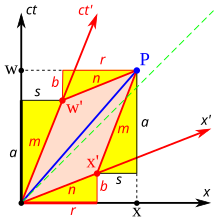
There have been many dozens of derivations of the Lorentz transformations since Einstein's original work in 1905, each with its particular focus. Although Einstein's derivation was based on the invariance of the speed of light, there are other physical principles that may serve as starting points. Ultimately, these alternative starting points can be considered different expressions of the underlying principle of locality, which states that the influence that one particle exerts on another can not be transmitted instantaneously.[29]
The derivation given here and illustrated in Fig. 2‑5 is based on one presented by Bais[27]: 64–66 and makes use of previous results from the Relativistic Composition of Velocities, Time Dilation, and Length Contraction sections. Event P has coordinates (w, x) in the black "rest system" and coordinates (w', x') in the red frame that is moving with velocity parameter β = v/c. How do we determine w' and x' in terms of w and x ? (Or the other way around, of course.)
It is easier at first to derive the inverse Lorentz transformation.
- We start by noting that there can be no such thing as length expansion/contraction in the transverse directions. y' must equal y and z' must equal z, otherwise whether a fast moving 1 m ball could fit through a 1 m circular hole would depend on the observer. The first postulate of relativity states that all inertial frames are equivalent, and transverse expansion/contraction would violate this law.[30]: 27–28
- From the drawing, w = a + b and x = r + s
- From previous results using similar triangles, we know that s/a = b/r = v/c = β.
- We know that because of time dilation, a = γw'
- Substituting equation (4) into s/a = β yields s = γw'β.
- Length contraction and similar triangles give us r = γx' and b = βr = βγx'
- Substituting the expressions for s, a, r and b into the equations in Step 2 immediately yield
The above equations are alternate expressions for the t and x equations of the inverse Lorentz transformation, as can be seen by substituting ct for w, ct' for w', and v/c for β. From the inverse transformation, the equations of the forwards transformation can be derived by solving for t' and x'.
Linearity of the Lorentz transformations
The Lorentz transformations have a mathematical property called linearity, since x' and t' are obtained as linear combinations of x and t, with no higher powers involved. The linearity of the transformation reflects a fundamental property of spacetime that we tacitly assumed while performing the derivation, namely, that the properties of inertial frames of reference are independent of location and time. In the absence of gravity, spacetime looks the same everywhere.[27]: 67 All inertial observers will agree on what constitutes accelerating and non-accelerating motion.[30]: 72–73 Any one observer can use her own measurements of space and time, but there is nothing absolute about them. Another observer's conventions will do just as well.[12]: 190
A result of linearity is that if two Lorentz transformations are applied sequentially, the result is also a Lorentz transformation.
Example: Terence observes Stella speeding away from him at 0.500 c, and he can use the Lorentz transformations with β = 0.500 to relate Stella's measurements to his own. Stella, in her frame, observes Ursula traveling away from her at 0.250 c, and she can use the Lorentz transformations with β = 0.250 to relate Ursula's measurements with her own. Because of the linearity of the transformations and the relativistic composition of velocities, Terence can use the Lorentz transformations with β = 0.666 to relate Ursula's measurements with his own.
Doppler effect
The Doppler effect is the change in frequency or wavelength of a wave for a receiver and source in relative motion. For simplicity, we consider here two basic scenarios: (1) The motions of the source and/or receiver are exactly along the line connecting them (longitudinal Doppler effect), and (2) the motions are at right angles to the said line (transverse Doppler effect). We are ignoring scenarios where they move along intermediate angles.
Longitudinal Doppler effect

The classical Doppler analysis deals with waves that are propagating in a medium, such as sound waves or water ripples, and which are transmitted between sources and receivers that are moving towards or away from each other. The analysis of such waves depends on whether the source, the receiver, or both are moving relative to the medium. Fig. 2‑6a illustrates a Galilean spacetime diagram of the scenario where the source is moving directly away from a receiver that is stationary with respect to the medium. The source travels at a speed of vs for a velocity parameter of βs. With the source moving, the wavelength is affected, resulting in a frequency change as perceived by the observer. In the figure, the green arrows depict the transmission of each pulse at constant speed c through the medium. If the period T0 of the pulses is 1 per unit of time, the received period is T = 1+βs, so that the observed frequency f is given by
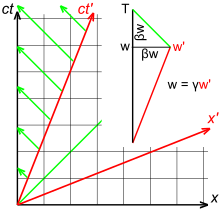
Fig. 2‑6b illustrates a Galilean spacetime diagram of the scenario where the receiver is moving directly away from a stationary source at a speed of vr for a velocity parameter of βr. With the source stationary, the wavelength is not changed, but the transmission velocity of the waves relative to the observer is decreased. In the diagram inset, we see that period T = 1+a. The variable "a" is calculated by noting the similar triangle relationship (1+a)/a = a/(a−βr), so that T = 1/(1−βr) and the observed frequency f is given by
Light, unlike sound or water ripples, does not propagate through a medium, and there is no distinction between a source moving away from the receiver or a receiver moving away from the source. Fig. 2‑7 illustrates a relativistic spacetime diagram showing a source separating from the receiver with a velocity parameter β, so that the separation between source and receiver at time w is βw. Because of time dilation, w = γw'. Since the slope of the green light ray is −1, T = w+βw = γw'(1+β). Hence, the relativistic Doppler effect is given by[27]: 58–59
Transverse Doppler effect

Suppose that a source, moving in a straight line, is at its closest point to the receiver. It would appear that the classical analysis predicts that the receiver detects no Doppler shift. Due to subtleties in the analysis, that expectation is not necessarily true. Nevertheless, when appropriately defined, transverse Doppler shift is a relativistic effect that has no classical analog. The subtleties are these:[30]: 94–96
- Fig. 2-8a. If a source, moving in a straight line, is crossing the receiver's field of view, what is the frequency measurement when the source is at its closest approach to the receiver?
- Fig. 2-8b. If a source is moving in a straight line, what is the frequency measurement when the receiver sees the source as being closest to it?
- Fig. 2-8c. If receiver is moving in a circle around the source, what frequency does the receiver measure?
- Fig. 2-8d. If the source is moving in a circle around the receiver, what frequency does the receiver measure?
In scenario (a), when the source is closest to the receiver, the light hitting the receiver actually comes from a direction where the source had been some time back, and it has a significant longitudinal component, making an analysis from the frame of the receiver tricky. It is easier to make the analysis from S', the frame of the source. The point of closest approach is frame-independent and represents the moment where there is no change in distance versus time (i.e. dr/dt = 0 where r is the distance between receiver and source) and hence no longitudinal Doppler shift. The source observes the receiver as being illuminated by light of frequency f', but also observes the receiver as having a time-dilated clock. In frame S, the receiver is therefore illuminated by blueshifted light of frequency
Scenario (b) is best analyzed from S, the frame of the receiver. The illustration shows the receiver being illuminated by light from when the source was closest to the receiver, even though the source has moved on. Because the source's clocks are time dilated, and since dr/dt was equal to zero at this point, the light from the source, emitted from this closest point, is redshifted with frequency
Scenarios (c) and (d) can be analyzed by simple time dilation arguments. In (c), the receiver observes light from the source as being blueshifted by a factor of , and in (d), the light is redshifted. The only seeming complication is that the orbiting objects are in accelerated motion. However, if an inertial observer looks at an accelerating clock, only the clock's instantaneous speed is important when computing time dilation. (The converse, however, is not true.)[30]: 94–96 Most reports of transverse Doppler shift refer to the effect as a redshift and analyze the effect in terms of scenarios (b) or (d).[Note 4]
Energy and momentum
Four-momentum

In classical mechanics, the state of motion of a particle is characterized by its mass and its velocity. Linear momentum, the product of a particle's mass and velocity, is a vector quantity, possessing the same direction as the velocity: p = mv. It is a conserved quantity, meaning that if a closed system is not affected by external forces, its total linear momentum cannot change.
In relativistic mechanics, the momentum vector is extended to four dimensions. Added to the momentum vector is a time component that allows the spacetime momentum vector to transform like the spacetime position vector (x, t). In exploring the properties of the spacetime momentum, we start, in Fig. 2‑9a, by examining what a particle looks like at rest. In the rest frame, the spatial component of the momentum is zero, i.e. p = 0, but the time component equals mc.
We can obtain the components of the four-momentum in the moving frame by using the Lorentz transformations, or we can read it directly from the figure because we know that (mc)' = γmc and p' = −βγmc, since the red axes are rescaled by gamma. Fig. 2‑9b illustrates the situation as it appears in the moving frame. It is apparent that the space and time components of the four-momentum go to infinity as the velocity of the moving frame approaches c.[27]: 84–87
Momentum of light
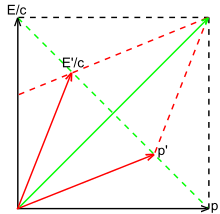
Light particles, or photons, travel at the speed of c, the constant that is conventionally known as the "speed of light". This statement is not a tautology, since many modern formulations of relativity do not start with constant speed of light as a postulate. Photons therefore propagate along a light-like world line and, in appropriate units, have equal space and time components for every observer.
A consequence of Maxwell's theory of electromagnetism is that light carries energy and momentum, and that their ratio is a constant: E/p = c. Rearranging, E/c = p, and since for photons, the space and time components are equal, E/c must therefore be equated with the time component of the spacetime momentum vector.
Photons travel at the speed of light, yet have finite momentum and energy. For this to be so, the mass term in γmc must be zero, meaning that photons are massless particles. Infinity times zero is an ill-defined quantity, but E/c is well-defined.
By this analysis, if the energy of a photon equals E in the rest frame, it equals E' = (1 − β)γE in a moving frame. This result can by derived by inspection of Fig. 2‑10 or by application of the Lorentz transformations, and is consistent with the analysis of Doppler effect given previously.[27]: 88
Mass-energy relationship
Consideration of the interrelationships between the various components of the relativistic momentum vector led Einstein to several famous conclusions.
- In the low speed limit as β = v/c approaches zero, approaches 1, so the spatial component of the relativistic momentum βγmc = γmv approaches mv, the classical term for momentum. Following this perspective, γm can be interpreted as a relativistic generalization of m. Einstein proposed that the "relativistic mass" of an object increases with velocity according to the formula mrel = γm.
- Likewise, comparing the time component of the relativistic momentum with that of the photon, γmc = mrelc = E/c, so that Einstein arrived at the relationship E = mrelc2. Simplified to the case of zero velocity, this is Einstein's famous equation relating energy and mass.
Another way of looking at the relationship between mass and energy is to consider the time component of the relativistic momentum vector at low velocity. A series expansion of γm yields
In other words, at low velocity, mrel = m + ½ mv2/c2. The second term is just an expression for the kinetic energy of the particle divided by c2. Mass indeed appears to be another form of energy.[27]: 90–92 [30]: 129–130, 180
The concept of relativistic mass that Einstein introduced in 1905, mrel, although amply validated every day in particle accelerators around the globe (or indeed in any instrumentation whose use depends on high velocity particles, such as electron microscopes, old-fashioned color television sets, etc.), has nevertheless not proven to be a fruitful concept in physics in the sense that it is not a concept that has served as a basis for other theoretical development. Relativistic mass, for instance, plays no role in general relativity.
For this reason, as well as for pedagogical concerns, most physicists currently prefer a different terminology when referring to the relationship between mass and energy.[31] "Relativistic mass" is a deprecated term. The term "mass" by itself refers to the rest mass or invariant mass, and is equal to the invariant length of the relativistic momentum vector (E, pc). Expressed as a formula,
This formula applies to all particles, massless as well as massive. For massless photons, it yields the same relationship that we had earlier established, E = ±pc.[27]: 90–92
Because of the close relationship between mass and energy, the four-momentum (also called 4‑momentum) is also called the energy-momentum 4‑vector. Using an uppercase P to represent the four-momentum and a lowercase p to denote the spatial momentum, the four-momentum may be written as
- or alternatively,
- using the convention that [30]: 129–130, 180
Conservation laws
In physics, conservation laws state that certain particular measurable properties of an isolated physical system do not change as the system evolves over time. In 1915, Emmy Noether discovered that underlying each conservation law is a fundamental symmetry of nature.[32] The fact that physical processes don't care where in space they take place (space translation symmetry) yields conservation of momentum, the fact that such processes don't care when they take place (time translation symmetry) yields conservation of energy, and so on. In this section, we examine the Newtonian views of conservation of mass, momentum and energy from a relativistic perspective.
Total momentum
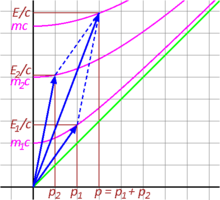
To understand how the Newtonian view of conservation of momentum needs to be modified in a relativistic context, we examine the problem of two colliding bodies limited to a single dimension.
In Newtonian mechanics, two extreme cases of this problem may be distinguished yielding mathematics of minimum complexity: (1) The two bodies rebound from each other in a completely elastic collision. (2) The two bodies stick together and continue moving as a single particle. This second case is the case of completely inelastic collision. For both cases (1) and (2), momentum, mass, and total energy are conserved. However, kinetic energy is not conserved in cases of inelastic collision. A certain fraction of the initial kinetic energy is converted to heat.
In case (2), two masses with momentums p1 = m1v1 and p2 = m2v2 collide to produce a single particle of conserved mass m = m1 + m2 traveling at the center of mass velocity of the original system, vcm = (m1v1 + m2v2)/(m1 + m2). The total momentum p = p1 + p2 is conserved.
Fig. 2‑11 illustrates the inelastic collision of two particles from a relativistic perspective. The time components E1/c and E2/c add up to total E/c of the resultant vector, meaning that energy is conserved. Likewise, the space components p1 and p2 add up to form p of the resultant vector. The four-momentum is, as expected, a conserved quantity. However, the invariant mass of the fused particle, given by the point where the invariant hyperbola of the total momentum intersects the energy axis, is not equal to the sum of the invariant masses of the individual particles that collided. Indeed, it is larger than the sum of the individual masses: m > m1 + m2.[27]: 94–97
Looking at the events of this scenario in reverse sequence, we see that non-conservation of mass is a common occurrence: when an unstable elementary particle spontaneously decays into two lighter particles, total energy is conserved, but the mass is not. Part of the mass is converted into kinetic energy.[30]: 134–138
Choice of reference frames
The freedom to choose any frame in which to perform an analysis allows us to pick one which may be particularly convenient. For instance, whereas in conventional spacetime diagrams, the equivalence between the rest and moving frames is not immediately evident, if one chooses a third reference frame between the resting and moving frames with the two other frames moving in opposite directions with equal speed (the median frame), the result, often called a "Loedel diagram" (although it was independently developed by multiple authors), has equal units of length and time for both axes.[33][34][35][36]
For analysis of momentum and energy problems, the most convenient frame is usually the "center-of-momentum frame" (also called the zero-momentum frame, or COM frame). This is the frame in which the space component of the system's total momentum is zero. Fig. 2‑12 illustrates the breakup of a high speed particle into two daughter particles. In the lab frame, the daughter particles are preferentially emitted in a direction oriented along the original particle's trajectory. In the COM frame, however, the two daughter particles are emitted in opposite directions, although their masses and the magnitude of their velocities are generally not the same.
Energy and momentum conservation
In a Newtonian analysis of interacting particles, transformation between frames is simple because all that is necessary is to apply the Galilean transformation to all velocities. Since v' = v − u, the momentum p' = p − mu. If the total momentum of an interacting system of particles is observed to be conserved in one frame, it will likewise be observed to be conserved in any other frame.[30]: 241–245
Conservation of momentum in the COM frame amounts to the requirement that p = 0 both before and after collision. In the Newtonian analysis, conservation of mass dictates that m = m1 + m2. In the simplified, one-dimensional scenarios that we have been considering, only one additional constraint is necessary before the outgoing momenta of the particles can be determined—an energy condition. In the one-dimensional case of a completely elastic collision with no loss of kinetic energy, the outgoing velocities of the rebounding particles in the COM frame will be precisely equal and opposite to their incoming velocities. In the case of a completely inelastic collision with total loss of kinetic energy, the outgoing velocities of the rebounding particles will be zero.[30]: 241–245
Newtonian momenta, calculated as p = mv, fail to behave properly under Lorentzian transformation. The linear transformation of velocities v' = v − u is replaced by the highly nonlinear v' = (v − u)/(1 − vu/c2), so that a calculation demonstrating conservation of momentum in one frame will be invalid in other frames. Einstein was faced with either having to give up conservation of momentum, or to change the definition of momentum. As we have discussed earlier in the section on four-momentum, this second option was what he chose.[27]: 104
The relativistic conservation law for energy and momentum replaces the three classical conservation laws for energy, momentum and mass. Mass is no longer conserved independently, because it has been subsumed into the total relativistic energy. This makes the relativistic conservation of energy a simpler concept than in nonrelativistic mechanics, because the total energy is conserved without any qualifications. Kinetic energy converted into heat or internal potential energy shows up as an increase in mass.[30]: 127
Example: Because of the equivalence of mass and energy, elementary particle masses are customarily stated in energy units, where 1 MeV = 1×106 electron volts. A charged pion is a particle of mass 139.57 MeV (approx. 273 times the electron mass). It is unstable, and decays into a muon of mass 105.66 MeV (approx. 207 times the electron mass) and an antineutrino, which has an almost negligible mass. The difference between the pion mass and the muon mass is 33.91 MeV.
Fig. 2‑13a illustrates the energy-momentum diagram for this decay reaction in the rest frame of the pion. Because of its negligible mass, a neutrino travels at very nearly the speed of light. The relativistic expression for its energy, like that of the photon, is which is also the value of the space component of its momentum. To conserve momentum, the muon has the same value of the space component of the neutrino's momentum, but in the opposite direction.
Algebraic analyses of the energetics of this decay reaction are available online,[37] so Fig. 2‑13b presents instead a graphing calculator solution. The energy of the neutrino is 29.79 MeV, and the energy of the muon is 33.91 − 29.79 = 4.12 MeV. Interestingly, most of the energy is carried off by the near-zero-mass neutrino.
Acceleration
It is a common misconception that special relativity is applicable only to inertial frames, and that it is unable to handle accelerating objects or accelerating reference frames. Actually, accelerating objects can generally be analyzed without needing to deal with accelerating frames at all. It is only when gravitation is significant that general relativity is required.[38]
Properly handling accelerating frames does requires some care, however. The difference between special and general relativity is that (1) in special relativity, all velocities are relative, but acceleration is absolute; (2) whereas in general relativity, all motion is relative, whether inertial, accelerating, or rotating. To accommodate this difference, general relativity uses curved spacetime.[38]
In this section, we analyze several scenarios involving accelerated reference frames.
Dewan–Beran–Bell spaceship paradox
Elementary introductions to special relativity often illustrate the differences between Galilean relativity and special relativity by posing a series of supposed "paradoxes". All paradoxes are, in reality, merely ill-posed or misunderstood problems, resulting from our unfamiliarity with velocities comparable to the speed of light. The remedy is to solve many problems in special relativity and to become familiar with its so-called counter-intuitive predictions. The geometrical approach to studying spacetime is considered one of the best methods for developing a modern intuition.[39]
The Dewan–Beran–Bell spaceship paradox (Bell's spaceship paradox) is a good example of a problem where intuitive reasoning unassisted by the geometric insight of the spacetime approach can lead to issues.

In Fig. 2‑14, two identical spaceships float in space and are at rest relative to each other. They are connected by a string which is capable of only a limited amount of stretching before breaking. At a given instant in our frame, the observer frame, both spaceships accelerate in the same direction along the line between them with the same constant proper acceleration. Will the string break?
The main article for this section recounts how, when the paradox was new and relatively unknown, even professional physicists had difficulty working out the solution. Two lines of argument lead to opposite conclusions. Both lines of argument presented below are flawed, even though one of the conclusions happens to be the correct conclusion.[30]: 106, 120–122
- To observers in the rest frame, the spaceships start a distance L apart and remain the same distance apart during acceleration. During acceleration, L is a length contracted distance of the distance L' = γL in the frame of the accelerating spaceships. After a sufficiently long time, γ will increase to a sufficiently large factor that the string must break.
- Let A and B be the rear and front spaceships. In the frame of the spaceships, each spaceship sees the other spaceship doing the same thing that it is doing. A says that B has the same acceleration that he has, and B sees that A matches her every move. So the spaceships stay the same distance apart, and the string does not break.[30]: 106, 120–122
The problem with the first argument is that there is no "frame of the spaceships." There cannot be, because the two spaceships measure a growing distance between the two. Because there is no common frame of the spaceships, the length of the string is ill-defined. Nevertheless, the conclusion is correct, and the argument is mostly right. The second argument, however, completely ignores the relativity of simultaneity.[30]: 106, 120–122

A spacetime diagram (Fig. 2‑15) makes the correct solution to this paradox almost immediately evident. Two observers in Minkowski spacetime accelerate with constant magnitude acceleration for proper time (acceleration and elapsed time measured by the observers themselves, not some inertial observer). They are comoving and inertial before and after this phase. In Minkowski geometry, the length of the spacelike line segment turns out to be greater than the length of the spacelike line segment .
The length increase can be calculated with the help of the Lorentz transformation. If, as illustrated in Fig. 2‑15, the acceleration is finished, the ships will remain at a constant offset in some frame If and are the ships' positions in the positions in frame are:[40]
Accelerated observer with horizon
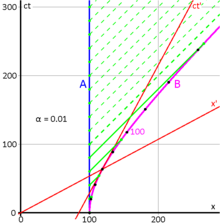
In the text accompanying Fig. 1‑10, we had noted that the magenta hyperbolae represented actual paths that could be traversed by a continuously accelerating traveler in spacetime. After a long period of acceleration, the traveler's velocity approaches the speed of light, while the traveler's acceleration, measured in our frame, continuously decreases.
Fig. 2‑16 details various features of the traveler's motions with more specificity. At any given moment, her space axis is formed by a line passing through the origin and her current position on the hyperbola, while her time axis is the tangent to the hyperbola at her position. The velocity parameter approaches a limit of one as increases. Likewise, approaches infinity.
The shape of the invariant hyperbola corresponds to a path of constant proper acceleration. This is demonstrable as follows:
- We remember that
- Since we conclude that
- From the relativistic force law,
- Substituting from step 2 and the expression for from step 3 yields which is a constant expression.[27]: 110–113
Fig. 2‑16 illustrates a specific calculated scenario. Terence (A) and Stella (B) initially stand together 100 light hours from the origin. Stella lifts off at time 0, her spacecraft accelerating at 0.01 c per hour. Every twenty hours, Terence radios updates to Stella about the situation at home (thick green lines). Stella receives these regular transmissions, but the effect of Doppler shift (offset in part by time dilation) causes her to receive Terence's communications later and later as measured on her clock, and she never receives Terence's 100 hour communication.: 110–113
After 100 hours according to Terence's clock, Stella enters a dark region. She has traveled outside Terence's timelike future. On the other hand, Terence can continue to receive Stella's messages to him indefinitely. He just has to wait long enough. Spacetime has been divided into distinct regions separated by an "apparent" event horizon. So long as Stella continues to accelerate, she can never know what takes place behind this horizon.: 110–113
Foreshadowings of the spacetime concept
In myth and literature
Incas regarded space and time as a single concept, referred to as pacha (Quechua: pacha, Aymara: pacha).[41][42] The peoples of the Andes maintain a similar understanding.[43]
The idea of a unified spacetime is stated by Edgar Allan Poe in his essay on cosmology titled Eureka (1848) that "Space and duration are one". In 1895, in his novel The Time Machine, H. G. Wells wrote, "There is no difference between time and any of the three dimensions of space except that our consciousness moves along it", and that "any real body must have extension in four directions: it must have Length, Breadth, Thickness, and Duration".
In math and physics
In Encyclopedie, published in 1754, under the term dimension Jean le Rond d'Alembert speculated that duration (time) might be considered a fourth dimension if the idea was not too novel.[44]
Another early venture was by Joseph Louis Lagrange in his Theory of Analytic Functions (1797, 1813). He said, "One may view mechanics as a geometry of four dimensions, and mechanical analysis as an extension of geometric analysis".[45]
The ancient idea of the cosmos gradually was described mathematically with differential equations, differential geometry, and abstract algebra. These mathematical articulations blossomed in the nineteenth century as electrical technology stimulated men like Michael Faraday and James Clerk Maxwell to describe the reciprocal relations of electric and magnetic fields. Daniel Siegel phrased Maxwell's role in relativity as follows:
[...] the idea of the propagation of forces at the velocity of light through the electromagnetic field as described by Maxwell's equations—rather than instantaneously at a distance—formed the necessary basis for relativity theory.[46]: 189
Maxwell used vortex models in his papers on On Physical Lines of Force, but ultimately gave up on any substance but the electromagnetic field. Pierre Duhem wrote:
[Maxwell] was not able to create the theory that he envisaged except by giving up the use of any model, and by extending by means of analogy the abstract system of electrodynamics to displacement currents.[47]
In Siegel's estimation, "this very abstract view of the electromagnetic fields, involving no visualizable picture of what is going on out there in the field, is Maxwell's legacy."[46]: 191
Describing the behaviour of electric fields and magnetic fields led Maxwell to view the combination as an electromagnetic field. These fields have a value at every point of spacetime. The rate of motion of an observer determines the electric and magnetic profiles of the electromagnetic field. The propagation of the field is determined by the electromagnetic wave equation, which requires spacetime for description.[48]: 1–30
Various authors have credited W. K. Clifford with having anticipated the spacetime concept in general relativity as far back as 1870,[49][50] although the actual extent to which Clifford anticipated spacetime is debatable: in an 1876 publication, Clifford speculated that "curvature of space is what really happens in that phenomenon which we call the motion of matter", i.e. he speculated on the possibility of curved space, not curved spacetime.[51]
Spacetime in general relativity
| General relativity |
|---|
 |
In general relativity, it is assumed that spacetime is curved by the presence of matter (energy), this curvature being represented by the Riemann tensor. In special relativity, the Riemann tensor is identically zero, and so this concept of "non-curvedness" is sometimes expressed by the statement Minkowski spacetime is flat.[48]: 1–30
The earlier discussed notions of time-like, light-like and space-like intervals in special relativity can similarly be used to classify one-dimensional curves through curved spacetime. A time-like curve can be understood as one where the interval between any two infinitesimally close events on the curve is time-like, and likewise for light-like and space-like curves. Technically the three types of curves are usually defined in terms of whether the tangent vector at each point on the curve is time-like, light-like or space-like. The world line of a slower-than-light object will always be a time-like curve, the world line of a massless particle such as a photon will be a light-like curve, and a space-like curve could be the world line of a hypothetical tachyon. In the local neighborhood of any event, time-like curves that pass through the event will remain inside that event's past and future light cones, light-like curves that pass through the event will be on the surface of the light cones, and space-like curves that pass through the event will be outside the light cones. One can also define the notion of a three-dimensional "spacelike hypersurface", a continuous three-dimensional "slice" through the four-dimensional property with the property that every curve that is contained entirely within this hypersurface is a space-like curve.[52]
Many spacetime continua have physical interpretations which most physicists would consider bizarre or unsettling. For example, a compact spacetime has closed timelike curves, which violate our usual ideas of causality (that is, future events could affect past ones). For this reason, mathematical physicists usually consider only restricted subsets of all the possible spacetimes. One way to do this is to study "realistic" solutions of the equations of general relativity. Another way is to add some additional "physically reasonable" but still fairly general geometric restrictions and try to prove interesting things about the resulting spacetimes. The latter approach has led to some important results, most notably the Penrose–Hawking singularity theorems.[53]
Quantized spacetime
In general relativity, spacetime is assumed to be smooth and continuous—and not just in the mathematical sense. In the theory of quantum mechanics, there is an inherent discreteness present in physics. In attempting to reconcile these two theories, it is sometimes postulated that spacetime should be quantized at the very smallest scales. Current theory is focused on the nature of spacetime at the Planck scale. Causal sets, loop quantum gravity, string theory, causal dynamical triangulation, and black hole thermodynamics all predict a quantized spacetime with agreement on the order of magnitude. Loop quantum gravity makes precise predictions about the geometry of spacetime at the Planck scale.[54]
Spin networks provide a language to describe quantum geometry of space. Spin foam does the same job on spacetime. A spin network is a one-dimensional graph, together with labels on its vertices and edges which encodes aspects of a spatial geometry.[55]
Mathematics of spacetimes
For physical reasons, a spacetime continuum is mathematically defined as a four-dimensional, smooth, connected Lorentzian manifold . This means the smooth Lorentz metric has signature . The metric determines the geometry of spacetime, as well as determining the geodesics of particles and light beams. About each point (event) on this manifold, coordinate charts are used to represent observers in reference frames. Usually, Cartesian coordinates are used. Moreover, for simplicity's sake, units of measurement are usually chosen such that the speed of light is equal to 1.[56]
A reference frame (observer) can be identified with one of these coordinate charts; any such observer can describe any event . Another reference frame may be identified by a second coordinate chart about . Two observers (one in each reference frame) may describe the same event but obtain different descriptions.[56]
Usually, many overlapping coordinate charts are needed to cover a manifold. Given two coordinate charts, one containing (representing an observer) and another containing (representing another observer), the intersection of the charts represents the region of spacetime in which both observers can measure physical quantities and hence compare results. The relation between the two sets of measurements is given by a non-singular coordinate transformation on this intersection. The idea of coordinate charts as local observers who can perform measurements in their vicinity also makes good physical sense, as this is how one actually collects physical data—locally.[56]
For example, two observers, one of whom is on Earth, but the other one who is on a fast rocket to Jupiter, may observe a comet crashing into Jupiter (this is the event ). In general, they will disagree about the exact location and timing of this impact, i.e., they will have different 4-tuples (as they are using different coordinate systems). Although their kinematic descriptions will differ, dynamical (physical) laws, such as momentum conservation and the first law of thermodynamics, will still hold. In fact, relativity theory requires more than this in the sense that it stipulates these (and all other physical) laws must take the same form in all coordinate systems. This introduces tensors into relativity, by which all physical quantities are represented.
Geodesics are said to be time-like, null, or space-like if the tangent vector to one point of the geodesic is of this nature. Paths of particles and light beams in spacetime are represented by time-like and null (light-like) geodesics, respectively.[56]
Topology
The assumptions contained in the definition of a spacetime are usually justified by the following considerations.
The connectedness assumption serves two main purposes. First, different observers making measurements (represented by coordinate charts) should be able to compare their observations on the non-empty intersection of the charts. If the connectedness assumption were dropped, this would not be possible. Second, for a manifold, the properties of connectedness and path-connectedness are equivalent, and one requires the existence of paths (in particular, geodesics) in the spacetime to represent the motion of particles and radiation.[57]
Every spacetime is paracompact. This property, allied with the smoothness of the spacetime, gives rise to a smooth linear connection, an important structure in general relativity.[57] Some important theorems on constructing spacetimes from compact and non-compact manifolds include the following:
- A compact manifold can be turned into a spacetime if, and only if, its Euler characteristic is 0. (Proof idea: the existence of a Lorentzian metric is shown to be equivalent to the existence of a nonvanishing vector field.)
- Any non-compact 4-manifold can be turned into a spacetime.[58]
Spacetime symmetries
Often in relativity, spacetimes that have some form of symmetry are studied. As well as helping to classify spacetimes, these symmetries usually serve as a simplifying assumption in specialized work. Some of the most popular ones include:
- Axisymmetric spacetimes
- Spherically symmetric spacetimes
- Static spacetimes
- Stationary spacetimes
See also
- Basic introduction to the mathematics of curved spacetime
- Global spacetime structure
- Metric space
- Philosophy of space and time
Notes
- ^ There are two sign conventions in use in the relativity literature:
s2 = c2t2 − x2 − y2 − z2
and
s2 = −c2t2 + x2 + y2 + z2
These sign conventions are associated with the "metric signatures" (+ − − −) and (− + + +). A minor variation is to place the time coordinate last rather than first. Since it is unclear which sign convention is in greater use, one should simply accept the fact that these variations exist. - ^ Even though it has been many decades since Terrell and Penrose published their observations, popular writings continue to conflate measurement versus appearance. For example, Michio Kaku wrote in Einstein's Cosmos (W. W. Norton & Company, 2004. p. 65): "... imagine that the speed of light is only 20 miles per hour. If a car were to go down the street, it might look compressed in the direction of motion, being squeezed like an accordion down to perhaps 1 inch in length."
- ^ In a Cartesian plane, ordinary rotation leaves a circle unchanged. In spacetime, hyperbolic rotation preserves the hyperbolic metric.
- ^ "Most" is not the same as "all". For example, the Kündig experiment is an example of an experiment that was set up to measure transverse blueshift, with a Mössbauer source set up at the center of a centrifuge rotor and an absorber at the rim.
References
- ^ Rynasiewicz, Robert. "Newton's Views on Space, Time, and Motion". Stanford Encyclopedia of Philosophy. Metaphysics Research Lab, Stanford University. Retrieved 24 March 2017.
- ^ Davis, Philip J. (2006). Mathematics & Common Sense: A Case of Creative Tension. Wellesley, Massachusetts: A.K. Peters. p. 86. ISBN 9781439864326.
- ^ Rowland, Todd. "Manifold". Wolfram Mathworld. Wolfram Research. Retrieved 24 March 2017.
- ^ a b French, A.P. (1968). Special Relativity. Boca Raton, Florida: CRC Press. pp. 35–60. ISBN 0748764224.
- ^ a b c d e Collier, Peter (2014). A Most Incomprehensible Thing: Notes Towards a Very Gentle Introduction to the Mathematics of Relativity (2nd ed.). Incomprehensible Books. ISBN 9780957389458.
- ^ Taylor, Edwin F.; Wheeler, John Archibald (1966). Spacetime Physics: Introduction to Special Relativity (13th ed.). San Francisco: Freeman. pp. 17–22. ISBN 071670336X. Retrieved 14 April 2017.
- ^ Scherr, Rachel E.; Shaffer, Peter S.; Vokos, Stamatis (July 2001). "Student understanding of time in special relativity: Simultaneity and reference frames" (PDF). American Journal of Physics. 69 (S1): S24–S35. doi:10.1119/1.1371254. Retrieved 11 April 2017.
- ^ Hughes, Stefan (2013). Catchers of the Light: Catching Space: Origins, Lunar, Solar, Solar System and Deep Space. Paphos, Cyprus: ArtDeCiel Publishing. pp. 202–233. ISBN 9781467579926. Retrieved 7 April 2017.
- ^ Stachel, John (2005). "Fresnel's (Dragging) Coefficient as a Challenge to 19th Century Optics of Moving Bodies.". In Kox, A. J.; Eisenstaedt, Jean (eds.). The Universe of General Relativity. Boston: Birkhäuser. pp. 1–13. ISBN 081764380X. Archived from the original (PDF) on 13 April 2017.
- ^ a b c Pais, Abraham (1982). ""Subtle is the Lord-- ": The Science and the Life of Albert Einstein (11th ed.). Oxford: Oxford University Press. ISBN 019853907X.
- ^ a b Miller, Arthur I. (1998). Albert Einstein's Special Theory of Relativity. New York: Springer-Verlag. ISBN 0387948708.
- ^ a b c d e f g h i j k Schutz, Bernard (2004). Gravity from the Ground Up: An Introductory Guide to Gravity and General Relativity (Reprint ed.). Cambridge: Cambridge University Press. ISBN 0521455065. Retrieved 24 May 2017.
- ^ Curiel, Erik; Bokulich, Peter. "Lightcones and Causal Structure". Stanford Encyclopedia of Philosophy. Metaphysics Research Lab, Stanford University. Retrieved 26 March 2017.
- ^ Savitt, Steven. "Being and Becoming in Modern Physics. 3. The Special Theory of Relativity". The Stanford Encyclopedia of Philosophy. Metaphysics Research Lab, Stanford University. Retrieved 26 March 2017.
- ^ Terrell, James. "Invisibility of the Lorentz Contraction". Physical Reviewdate=15 November 1959. 116 (4): 1041–1045. Bibcode:1959PhRv..116.1041T. doi:10.1103/PhysRev.116.1041.
- ^ Penrose, Roger (24 October 2008). "The Apparent Shape of a Relativistically Moving Sphere". Mathematical Proceedings of the Cambridge Philosophical Society. 55 (01): 137. Bibcode:1959PCPS...55..137P. doi:10.1017/S0305004100033776.
- ^ Cook, Helen. "Relativistic Distortion". Mathematics Department, University of British Columbia. Retrieved 12 April 2017.
- ^ Signell, Peter. "Appearances at Relativistic Speeds". Project PHYSNET. Michigan State University, East Lansing, MI. Archived from the original (PDF) on 12 April 2017. Retrieved 12 April 2017.
- ^ Kraus, Ute. "The Ball is Round". Space Time Travel: Relativity visualized. Institut für Physik Universität Hildesheim. Archived from the original on 16 April 2017. Retrieved 16 April 2017.
- ^ Zensus, J. Anton; Pearson, Timothy J. (1987). Superluminal Radio Sources (1st ed.). Cambridge, New York: Cambridge University Press. p. 3. ISBN 9780521345606.
- ^ Chase, Scott I. "Apparent Superluminal Velocity of Galaxies". The Original Usenet Physics FAQ. Department of Mathematics, University of California, Riverside. Retrieved 12 April 2017.
- ^ Richmond, Michael. ""Superluminal" motions in astronomical sources". Physics 200 Lecture Notes. School of Physics and Astronomy, Rochester Institute of Technology. Archived from the original on 19 April 2017. Retrieved 20 April 2017.
- ^ Keel, Bill. "Jets, Superluminal Motion, and Gamma-Ray Bursts". Galaxies and the Universe - WWW Course Notes. Department of Physics and Astronomy, University of Alabama. Archived from the original on 29 April 2017. Retrieved 29 April 2017.
- ^ a b c d e f Weiss, Michael. "The Twin Paradox". The Physics and Relativity FAQ. Retrieved 10 April 2017.
- ^ Mould, Richard A. (1994). Basic Relativity (1st ed.). Springer. p. 42. ISBN 9780387952109. Retrieved 22 April 2017.
- ^ Lerner, Lawrence S. (1997). Physics for Scientists and Engineers, Volume 2 (1st ed.). Jones & Bartlett Pub. p. 1047. ISBN 9780763704605. Retrieved 22 April 2017.
- ^ a b c d e f g h i j k l m Bais, Sander (2007). Very Special Relativity: An Illustrated Guide. Cambridge, Massachusetts: Harvard University Press. ISBN 067402611X.
- ^ Forshaw, Jeffrey; Smith, Gavin (2014). Dynamics and Relativity. John Wiley & Sons. p. 118. ISBN 9781118933299. Retrieved 24 April 2017.
- ^ Landau, L. D.; Lifshitz, E. M. (2006). The Classical Theory of Fields, Course of Theoretical Physics, Volume 2 (4th ed.). Amsterdam: Elsevier. pp. 1–24. ISBN 9780750627689.
- ^ a b c d e f g h i j k l m Morin, David (2017). Special Relativity for the Enthusiastic Beginner. CreateSpace Independent Publishing Platform. ISBN 9781542323512.
- ^ Griffiths, David J. (2013). Revolutions in Twentieth-Century Physics. Cambridge: Cambridge University Press. p. 60. ISBN 9781107602175. Retrieved 24 May 2017.
- ^ Byers, Nina. "E. Noether's Discovery of the Deep Connection Between Symmetries and Conservation Laws". arXiv.org. Cornell University. Retrieved 13 May 2017.
- ^ Mirimanoff, Dmitry (1921). "La transformation de Lorentz-Einstein et le temps universel de M. Ed. Guillaume". Archives des sciences physiques et naturelles (supplement). 5. 3: 46–48. (Translation: The Lorentz-Einstein transformation and the universal time of Ed. Guillaume)
- ^ Albert Shadowitz (2012). The Electromagnetic Field (Reprint of 1975 ed.). Courier Dover Publications. p. 460. ISBN 0486132013.
- ^ Gruner, Paul; Sauter, Josef (1921). "Représentation géométrique élémentaire des formules de la théorie de la relativité". Archives des sciences physiques et naturelles. 5. 3: 295–296.
{{cite journal}}: Unknown parameter|lastauthoramp=ignored (|name-list-style=suggested) (help) (Translation: Elementary geometric representation of the formulas of the special theory of relativity) - ^ Loedel, Enrique (1948). "Aberracion y Relatividad". Anales soc. cient. argentina. 145: 3–13.
- ^ Nave, R. "Energetics of Charged Pion Decay". Hyperphysics. Department of Physics and Astronomy, Georgia State University. Retrieved 27 May 2017.
- ^ a b Gibbs, Philip. "Can Special Relativity Handle Acceleration?". The Physics and Relativity FAQ. math.ucr.edu. Retrieved 28 May 2017.
- ^ Schutz, Bernard F. (1985). A first course in general relativity. Cambridge, UK: Cambridge University Press. p. 26. ISBN 0521277035.
- ^ Franklin, Jerrold (2010). "Lorentz contraction, Bell's spaceships, and rigid body motion in special relativity". European Journal of Physics. 31 (2): 291–298. arXiv:0906.1919. Bibcode:2010EJPh...31..291F. doi:10.1088/0143-0807/31/2/006.
- ^ "Pacha: un concepto andino de espacio y tiempo. | Manga Quespi | Revista Española de Antropología Americana" (PDF). Revistas.ucm.es. Retrieved 17 December 2016.
- ^ Steele, Paul R.; Allen, Catherine J. (2004). Handbook of Inca Mythology. Santa Barbara, California: ABC-Clio. p. 86. ISBN 1576073548.
- ^ Ardener, Shirley (1997). Women and space: ground rules and social maps (2nd ed.). Oxford: Berg. p. 36. ISBN 0854967281.
- ^ "ARTFL Encyclopédie Search Results". artflsrv02.uchicago.edu. Retrieved 17 December 2016.
- ^ "Archibald : Time as a fourth dimension". Projecteuclid.org. 3 July 2007. Retrieved 17 December 2016.
- ^ a b Flood, Raymond; McCartney, Mark; Whitaker, Andrew (2014). James Clerk Maxwell: Perspectives on his Life and Work (1st ed.). Oxford: Oxford University Press. ISBN 9780199664375.
- ^ Duhem, Pierre (1991). The Aim and Structure of Physical Theory. Princeton: Princeton University Press. p. 98. ISBN 069102524X.
- ^ a b Carroll, Sean M. (2 December 1997). "Lecture Notes on General Relativity". University of California, Santa Barbara. Retrieved 15 April 2017.
{{cite journal}}: Cite journal requires|journal=(help) - ^ Bell, Eric Temple (1945). The Development of Mathematics. McGraw-Hill Inc. pp. 359–360. ISBN 9780070043305.
- ^ Weyl, Hermann (1923). Raum Zeit Materie. Berlin: Springer-Verlag. p. 101.
- ^ Clifford, William Kingdon (1876). "On the Space-Theory of Matter". Proceedings of the Cambridge philosophical society. 2: 157–158.
- ^ Eilstein, Helena (2002). A Collection of Polish Works on Philosophical Problems of Time and Spacetime. Dordrecht: Kluwer Academic Publishers. p. 32. ISBN 9781402006708. Retrieved 30 January 2017.
- ^ Senovilla, José M M; Garfinkle, David (25 June 2015). "The 1965 Penrose singularity theorem". Classical and Quantum Gravity. 32 (12): 124008. doi:10.1088/0264-9381/32/12/124008. Retrieved 14 April 2017.
- ^ Hooft, G. T. (2001). "Obstacles on the way towards the quantisation of space, time and matter—And possible resolutions" (PDF). Studies in History and Philosophy of Science Part B: Studies in History and Philosophy of Modern Physics. 32 (2): 157–180. Retrieved 14 April 2017.
- ^ Baez, John C. "An Introduction to Spin Foam Models of Quantum Gravity and BF Theory". Retrieved 14 April 2017.
- ^ a b c d Bär, Christian; Fredenhagen, Klaus (2009). "Lorentzian Manifolds". Quantum Field Theory on Curved Spacetimes: Concepts and Mathematical Foundations. Dordrecht: Springer. pp. 39–58. ISBN 9783642027796. Archived from the original (PDF) on 13 April 2017. Retrieved 14 April 2017.
- ^ a b Gray, R. Dale (2015). Manifolds, Groups, Bundles, and Spacetime. Lulu.com. pp. 103–126. ISBN 9781329408258. Retrieved 14 April 2017.
- ^ Israel, S.W.; Hawking, W. (1989). General Relativity: An Einstein Centenary Survey (1st ed.). Cambridge: Cambridge University Press. p. 219. ISBN 0521299284.
Further reading
- Barrow, John D.; Tipler, Frank J. (1986). The Anthropic Cosmological Principle (1st ed.). Oxford University Press. ISBN 978-0-19-282147-8. LCCN 87028148.
- George F. Ellis and Ruth M. Williams (1992) Flat and curved space–times. Oxford Univ. Press. ISBN 0-19-851164-7
- Lorentz, H. A., Einstein, Albert, Minkowski, Hermann, and Weyl, Hermann (1952) The Principle of Relativity: A Collection of Original Memoirs. Dover.
- Lucas, John Randolph (1973) A Treatise on Time and Space. London: Methuen.
- Penrose, Roger (2004). The Road to Reality. Oxford: Oxford University Press. ISBN 0-679-45443-8. Chpts. 17–18.
- Taylor, E. F.; Wheeler, John A. (1963). Spacetime Physics. W. H. Freeman. ISBN 0-7167-2327-1.
External links
- Albert Einstein on space-time 13th edition Encyclopædia Britannica Historical: Albert Einstein's 1926 article
- Encyclopedia of Space-time and gravitation Scholarpedia Expert articles
- Stanford Encyclopedia of Philosophy: "Space and Time: Inertial Frames" by Robert DiSalle.













































